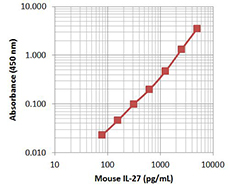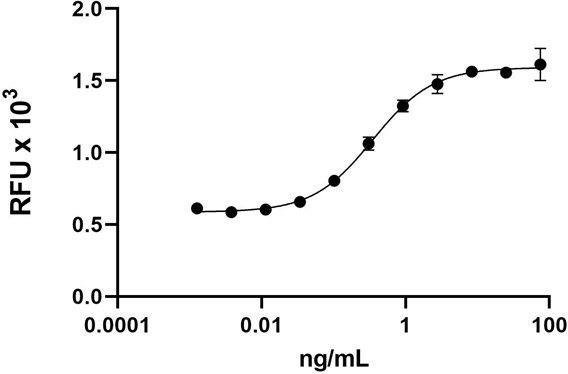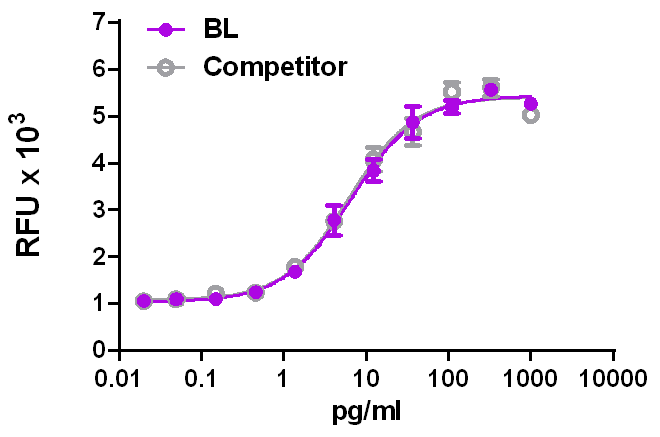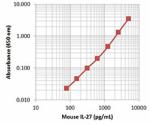- Clone
- B02P6E6 (See other available formats)
- Regulatory Status
- RUO
- Other Names
- Interleukin-27 p28, IL-27-A, IL-27 subunit alpha
- Isotype
- Rat IgG2a, κ
- Ave. Rating
- Submit a Review
- Product Citations
- publications

| Cat # | Size | Price | Quantity Check Availability | Save | ||
|---|---|---|---|---|---|---|
| 525903 | 50 µg | £101 | ||||
| 525904 | 500 µg | £286 | ||||
IL-27, a heterodimer protein, belongs to the IL-12 cytokine family. IL-27 is composed of the Epstein-Barr virus-induced gene 3 (EBI-3), a 34 kD glycoprotein that is related to the p40 subunit of IL-12; and p28, a 28 kD glycoprotein that is related to the p35 subunit of IL-12 and p19 subunit of IL-23.
IL-27 triggers expansion of antigen-specific naïve CD4+ T cells, promotes polarization of Th1 cells, and inhibits the development of Th2 and Th17 cells. It is known that IL-27 is an early product of activated antigen-presenting cells (APCs). IL-27 plays an important role in regulating the activity of B and T lymphocytes.
Product Details
- Verified Reactivity
- Mouse
- Antibody Type
- Monoclonal
- Host Species
- Rat
- Immunogen
- Recombinant mouse IL-27
- Formulation
- Phosphate-buffered solution, pH 7.2, containing 0.09% sodium azide.
- Preparation
- The antibody was purified by affinity chromatography and conjugated with biotin under optimal conditions.
- Concentration
- 0.5 mg/ml
- Storage & Handling
- The antibody solution should be stored undiluted between 2°C and 8°C. Do not freeze.
- Application
-
ELISA Detection - Quality tested
- Recommended Usage
-
Each lot of this antibody is quality control tested by ELISA assay. A concentration of 0.125 µg/ml of the capture antibody was utilized to generate the example standard curve. It is recommended that the end-user titrate each lot of reagents for optimal performance.
- Application Notes
-
ELISA Detection: To measure mouse IL-27, this antibody can be used as a detection antibody in sandwich ELISA format and paired with the purified MM27-7B1 antibody (Cat. No. 516902) as the capture antibody. Recombinant Mouse IL-27 (ELISA Std.) (Cat. No. 577409) can be used as the protein standard.
Note: For measuring mouse IL-27 in serum, plasma or cell culture supernatant, LEGEND MAX™ Mouse IL-27 Heterodimer ELISA Kit with Pre-coated Plates (Cat. No. 438707 & 438708) are specially developed and recommended. - RRID
-
AB_2563423 (BioLegend Cat. No. 525903)
AB_2563423 (BioLegend Cat. No. 525904)
Antigen Details
- Structure
- A heterodimeric cytokine consisting of EBV-induced gene-3 (EBI3, an IL-12 p40-related protein) and p28 (a newly discovered IL-12 p35-related protein).
- Distribution
- Produced by antigen-presenting cells, including macrophages and dendritic cells.
- Function
- Drives rapid clonal expansion of naïve CD4+ T cells, promotes Th1 polarization and IFN-γ production; plays a role in the anti-inflammatory and antitumor reponses, and has potential in autoimmune disease therapy.
- Interaction
- T cells and NK cells.
- Ligand/Receptor
- IL-27R (TCCR) (WSX-1).
- Cell Type
- Antigen-presenting cells, Macrophages, Dendritic cells, B cells
- Biology Area
- Apoptosis/Tumor Suppressors/Cell Death, Cell Biology, Immunology, Signal Transduction
- Molecular Family
- Cytokines/Chemokines
- Antigen References
-
1. Salcedo R, et al. 2004. J. Immunol. 173:7170.
2. Owaki T, et al. 2005. J. Immunol. 175:2191.
3. Pflanz S, et al. 2002. Immunity 16:779.
4. Diveu C, et al. 2009. J. Immunol. 182:5748.
5. Morishima N, et al. 2005. J. Immunol. 175:1686.
6. Liu J, et al. 2007. J. Exp. Med. 204:141. - Gene ID
- 246779 View all products for this Gene ID
- UniProt
- View information about IL-27 on UniProt.org
Related FAQs
- How many biotin molecules are per antibody structure?
- We don't routinely measure the number of biotins with our antibody products but the number of biotin molecules range from 3-6 molecules per antibody.
Other Formats
View All IL-27 Reagents Request Custom Conjugation| Description | Clone | Applications |
|---|---|---|
| Biotin anti-mouse IL-27 | B02P6E6 | ELISA Detection |
Customers Also Purchased
Compare Data Across All Formats
This data display is provided for general comparisons between formats.
Your actual data may vary due to variations in samples, target cells, instruments and their settings, staining conditions, and other factors.
If you need assistance with selecting the best format contact our expert technical support team.
 Login / Register
Login / Register 

















Follow Us